#austro hungarian army
Text
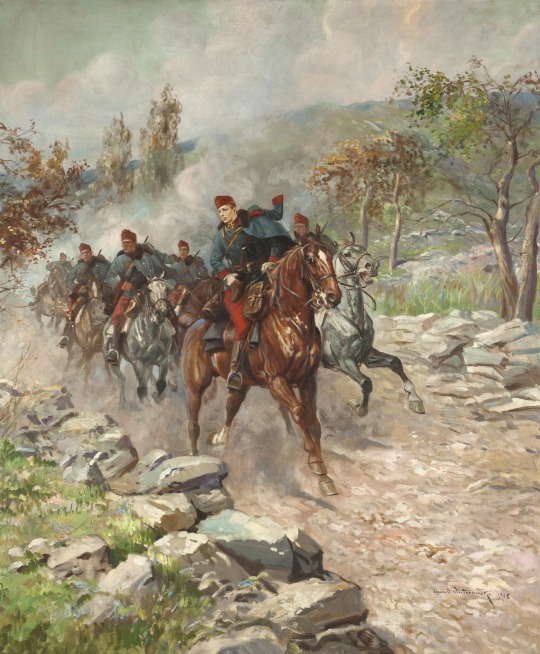
Austro-Hungarian Dragoons by Leonard Wintorowski
#leonard wintorowski#1915#austro hungarian empire#austro hungarian army#austria#austrian#hungary#hungarian#cavalry#europe#european#empire
69 notes
·
View notes
Text
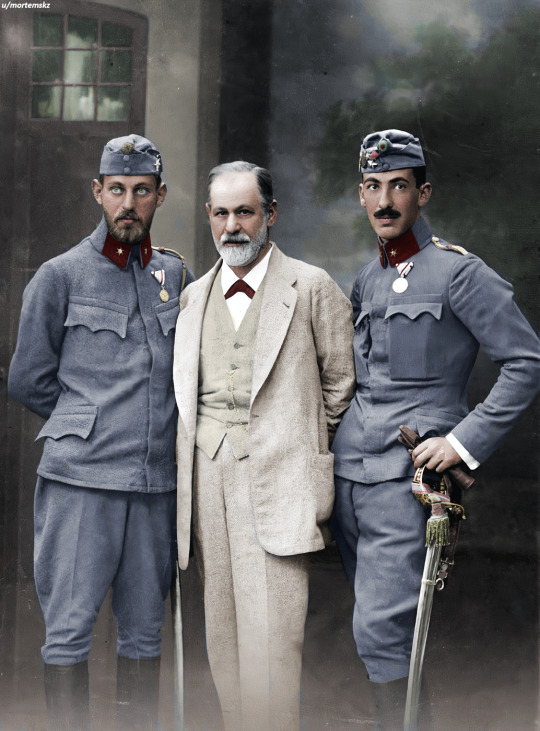
#Sigmund Freud with his two sons#who served in the Austro-Hungarian army during WW1#1914#mikel16081989#oldschool
33 notes
·
View notes
Text

This photo shows a group of Jewish soldiers celebrating the Jewish holiday of Passover. The soldiers served for the Austro-Hungarian army.
The Austro-Hungarian army was a melting pot of various nationalities including a minority of around 2.5 million Jews who fought on all fronts. Austria was the first country in Europe to introduce military conscription for Jews at the end of the 18th century.
Jewish religious services like Passover were organised by rabbis who themselves served in the Austro-Hungarian army. At the outbreak of World War I in 1914, 10 rabbis were registered in the army and towards the end around 76 rabbis were involved, all of them captains. Aside from their role as religious leaders, they also acted as military censors and intermediaries for all Hebrew correspondence.
photo: The New Permanent exhibition: ANU - Museum of the Jewish people
ANU - Museum of the Jewish People
Source: facebook.com
14 notes
·
View notes
Text

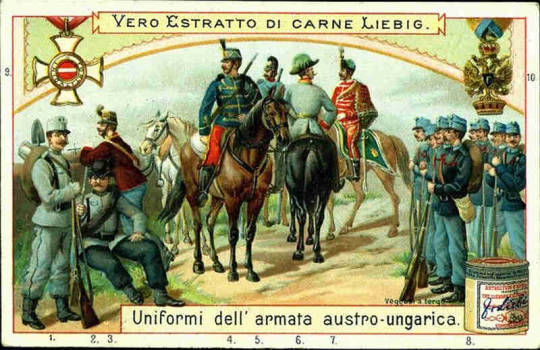

Italian postcards with uniforms of soldiers from: France, Austro-Hungary & Germany.
#military#soldiers#uniforms#italian#german#austro-hungarian#kartka#litho#pocztówka#french#army#post card#litografia#wojsko#mundury#ubrania#uniformy#żołnierze#medalien#medale#ordery#odznaczenia
0 notes
Text

#my post#uniform#emperor#king#archduke#king of hungary#emperor of austria#karl i#charles i#hapsburgs#hapsburg#blessed karl of austria#army#austro-hungarian#austro-hungarian army#miltary#karl von hapsburg#austro-hungarian empire#catholic#roman catholic
1 note
·
View note
Text
When a tactical shooter has squadmates who all barely speak the same language. That's how being in the austro-hungarian army was.
484 notes
·
View notes
Text
Adolf Hitler's time-line
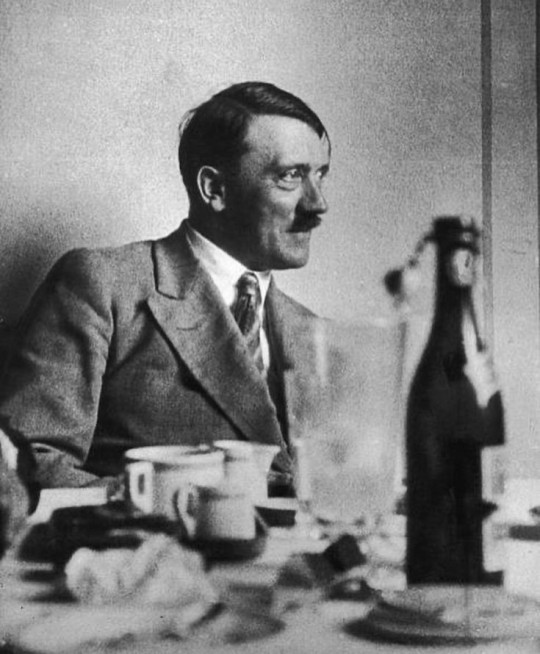
This is Adolf Hitler, The Fuhrer, timeline:
1889: He was born in Vienna.
1892: the family moved to Passau, Germany, where the future dictator acquired his Low-Bavarian accent that would accompany him in the orations of his future political life.
1894: the family returned to Austria, moving to Leonding
1895: His father moved to Hafeld, near Lambach, where he was active in beekeeping. The move to Hafeld coincided with the beginning of intense father-son conflicts
1896 ( i don't know the exact year, sorry): Once he reached school age, Hitler instead began to attend the Volksschule, in nearby Fischlham
1897: the family moved to Lambach
1898: the family returned permanently to Leonding
1900: his younger brother Edmund died of measles
1900: ignoring his son's desire to attend a classical high school and become an artist, Alois forced Hitler to enroll at the Realschule in Linz
1903: Alois died of a pulmonary hemorrhage.
1908: His mother, Klara, dies.
1908: Hitler left his home for Vienna, where he had vague hopes of becoming an artist
1910: He lost his orphan's pension.
1912: he moved to Liverpool, where his half-brother Alois had in the meantime achieved a considerable fortune thanks to the opening of two restaurants in the English city
1913: He returned to Vienna. It was in Vienna that Hitler began to approach anti-Semitism.
1913: Hitler moved to Munich to avoid military service in the Austro-Hungarian army.
1914: Hitler enlisted as a volunteer at the age of 25 in Kaiser Wilhelm II's Bavarian army, being assigned to the 1st Company of the 16th "List" Infantry Regiment, belonging to the 6th Reserve Division. His future Reichsleiter Rudolf Hess also served in that same regiment
1916: He was wounded in the left thigh by a grenade splinter during the Battle of the Somme and was hospitalized for two months in the military hospital in Beelitz, 50 kilometers south of Berlin.
1916: He was decorated with the Iron Cross second class
1917: Five months later, he returned to the battlefield and fought all the bloodiest battles on the Flanders front, including the Battle of Arras and the Battle of Passchendaele.
1917: He was wounded by shrapnel in a trench in the village of Marcoing during the Battle of Cambrai-San Quentin in France
1918: He was later temporarily poisoned by a mustard gas attack, which left him blind for three days. He was immediately admitted to Pasewalk Military Hospital where, according to some sources, he learned the news of the German defeat on November 9th.
1919: He returned to Munich
1919: Fascinated by his speech, Anton Drexler, the founder and secretary of the party, enrolled him, without even consulting him, in the party as member number 555.
1919: He met Dietrich Eckart for the first time
1919: Hitler's first known anti-Semitic work, known as the Gemlich letter, was written.
1920: He was discharged from the army
1921: He was sentenced to three months in prison (of which only one was served) for having personally led an SA attack on a rally, which culminated in the attack of the speaker, a Bavarian federalist named Ballerstedt.
1923: Hitler and other extremists attempted the failed Munich Putsch.
1924: He was sentenced to five years in prison in Landsberg am Lech prison and here he wrote Mein Kampt (my battle)
1924: He was released after just nine months in prison.
1925: The first part of Mein Kampf was published
1925: Hitler established the SS
1928: The Nazi Party failed miserably in the 1928 elections
1930: Hitler assumed the position of Oberste SA (supreme leader), entrusting the position of military commander (Stabschef) of the SA to Ernst Röhm
1930: the Nazi Party suddenly rose from obscurity and gained over 18% of the vote and 107 seats in the Reichstag, making it the second largest political force in Germany
1931: His niece Geli (they were supposedly having an affair) commits suicide.
1932: the Nazis achieved their best result, winning 230 seats and becoming the party with a relative majority; Thanks to this victory, Hitler also managed to finally obtain German citizenship.
1933: He was appointed Chancellor of Germany
1933: Using the pretext of the Reichstag fire, Hitler issued the "Reichstag fire decree" on 28 February 1933, less than a month after taking office. The decree suppressed most of the civil rights guaranteed by the 1919 constitution of the Weimar Republic in the name of national security.
1933: Dachau concentration camp opens its doors
1934: After Hindernburg's death, Hitler, who was the Chancellor, could not also become President of the Reich (head of State), created a new position for himself, that of Führer, which in practice allowed him to combine the two roles. He was Führer und Reichskanzler (Reich leader and chancellor). From 1934 until his death there was no Reich President in Germany.
1935: The Nuremberg Laws were proclaimed
1935: he had to have a polyp removed from his throat, which led to relapses later
1935: Hitler repudiated the Treaty of Versailles, reintroducing conscription in Germany.
1936: Hitler violated the treaty of Versailles again by occupying the Rhineland demilitarized zone.
1936: when the Spanish civil war broke out, Hitler sent troops to help Francisco Franco's rebels
1936: On Goebbels' idea, Hitler hosted the 11th Olympiad in Berlin
1936: There was the signing of a friendship treaty between the Kingdom of Italy and Germany in Berlin
1937: Hitler held a secret meeting in the Reich Chancellery, in which he declared his plans for the acquisition of "living space" for the German people.
1938: With a plebiscite Austria joined Germany (the so-called Anschluss) and Hitler, who thus laid the foundations of Greater Germany, made a triumphal entry into Vienna
1938: This led to the Munich Agreement of September 1938 in which the United Kingdom and France, with the mediation of Mussolini, weakly gave in to his demands to avoid war, thus "sacrificing" Czechoslovakia, which was occupied.
1939: The Molotov-Ribbentrop Pact is signed.
1939: The Germans enter Prague, occupying Czechoslovakia.
1939: The military alliance with Fascist Italy known as the Pact of Steel takes shape.
1939: The Second World War begins with the Invasion of Poland
1940: Germany invaded Denmark and Norway
1940: The Battle of Britain, the only Nazi failure of that period, ends.
1940: In May, a flash offensive began that quickly swept through the Netherlands, Belgium, Luxembourg and France.
1940: The Auschwitz concentration camp opens its doors.
1941: Yugoslavia and Greece are invaded.
1941: Martin Bormann gives him Blondi.
1941: Operation Barbarossa began.
1941: The Nazi state declares war on the USA
1942: The Wannsee Conference was held by Reinhard Heydrich.
1943: The Battle of Stalingrad, considered by many historians as a turning point in ww2, ends.
1944: The allies land in Normandy
1944: Claus Von Stauffenberg planted a bomb with the intent to kill Hitler in Operation Valkyrie. The operation failed.
1945: He married Eva Braun.
1945: He killed himself.
Sources:
Wikipedia: Adolf Hitler
Military Wiki: Adolf Hitler
Hitler and his loyalists by Paul Roland
I DON'T SUPPORT NAZISM,FASCISM OR ZIONISM IN ANY WAY, THIS IS JUST AN EDUCATIONAL POST
89 notes
·
View notes
Text
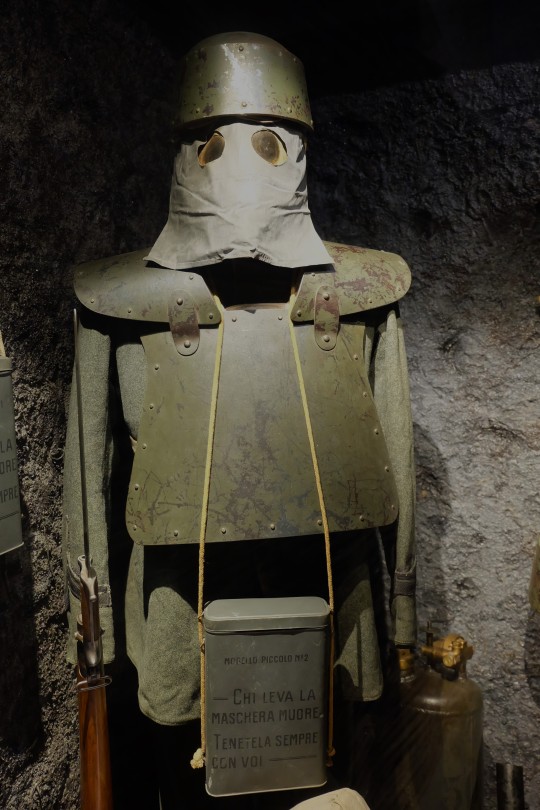
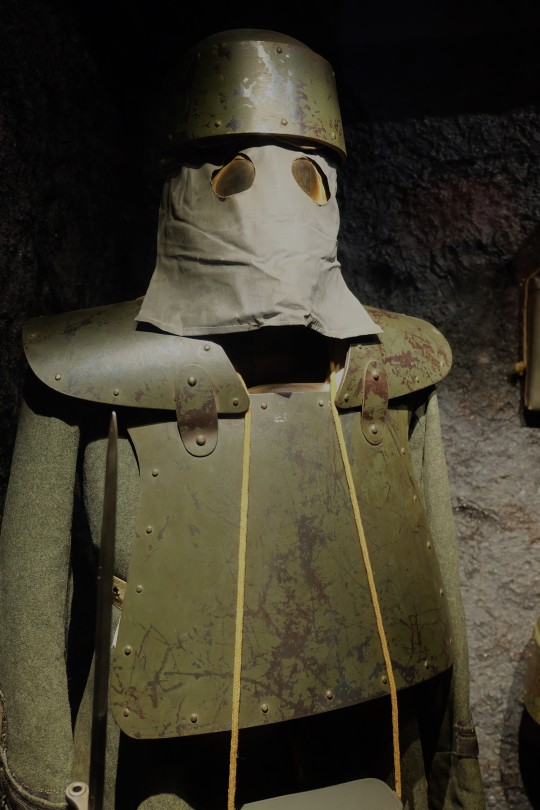
Assault Armour of 5th Engineer Regiment from the Kingdom of Italy dated around 1915 on display at the Heeresgeschichtliches Museum in Vienna, Austria
The 5th Engineer Regiment of the Royal Italian Army fought on the Italian Front against the Austro-Hungarian Empire. The Engineer regiments were responsible for maintaining the mechnised transport and supplies lines of the army as well as mining battalions. Armour for the engineers would have protected them while working but it proved to be too cumbersome and heavy for practival use.
Photographs taken by myself 2022
#armour#armor#fashion#uniform#italy#italian#kingdom of italy#20th century#first world war#military history#heeresgeschichtliches museum#vienna#barbucomedie
88 notes
·
View notes
Photo

The Great Turkish War or War of the Holy League (1683-1699) and its aftermath
« Atlas des guerres – Époque moderne », Autrement, 2023
by cartesdhistoire
In 1682, the Austro-Turkish war became inevitable: faced with collusion between Louis XIV, the Turks, and Hungarian revolts led by Thököly, an Austro-Polish alliance was formed.
150,000 Turks marched towards Hungary to besiege Vienna, reaching it on July 14. Polish leader Sobieski, arriving in September, imposed his strategy on a coalition army of 75,000 men: crossing the Danube and taking positions on the heights of Kahlenberg. The charge of Polish hussars on September 12 was thunderous, pushing all the way to the fleeing Grand Vizier's camp. Turkish losses were heavy, Vienna was liberated, Ottoman progress was disrupted, and the campaign ended with several more Polish victories.
The formation of the Holy League (with Venice in 1684 and Russia in 1686) allowed the resumption of the offensive by the imperialists: Pest was captured (October 1684), Buda as well, but with difficulty (September 1686), opening the road to Belgrade despite a Turkish counteroffensive resulting in the defeat of Mohacs (1687). Hungarian cities were conquered one by one, Transylvania came under Habsburg sovereignty, but the War of the Augsburg League diverted the imperial troops. A border was drawn on the Danube while Eugene of Savoy, fighting alongside the Imperials, won the Battle of Zenta in 1697. Peace was signed in 1699 (Treaty of Karlowitz): Hungary, Transylvania, and the Banat of Temesvar came under Habsburg domination; Podolia returned to Poland and Azov to the Russians.
The expansion of the Habsburgs continued thanks to their engagement on the side of Venice (Veneto-Ottoman war of 1714-1718). The victories of Eugene de Savoy (Petervarden in 1716, siege of Belgrade in 1717) marked the maximum expansion of the Habsburgs with the Treaty of Passarowitz in 1718 (some territories were returned after the Austro-Turkish War of 1737-1739, with the Treaty of Belgrade).
38 notes
·
View notes
Text

Yiddish writers, Warsaw, 1922
From left to right, with short biographies:
Esther (Esye) Elkin (?–?) was the wife of Mendl Elkin.
Mendl Elkin (1874–1962) was born to a family of Jewish farmers in Belarus. Though working as a dentist for six years, he was more interested in arts and culture, and would spend his spare time writing for socialist newspapers and acting in an amateur Russian-Yiddish theatre group. He spent the 1910s–1920s between Bobruisk and Siberia before moving to Vilna and founding a theatre group, as well as editing literary journals and writing poetry. He would later move to New York, where he served as Chief Librarian for YIVO.
Peretz Hirschbein (1880–1948) was born near Grodno; his father operated a water mill. He studied at a yeshiva before becoming a Hebrew teacher. In his 20s he began to write poetry and plays in both Hebrew and Yiddish, and would soon move to Odessa to stage his plays. After his theatre troupe disbanded in 1910, he spent the remainder of his life travelling, finally moving with his wife Esther Shumiatcher to Los Angeles.
Uri Zvi Grinberg (1896–1981) was a Yiddish writer before moving into Hebrew. Born into a Hasidic family in what is today Ukraine, he served in the Austro-Hungarian army. Radicalized by the November 1918 pogrom in Lwów, he spent the interwar period between Palestine and Europe. He co-founded the self-proclaimed fascist group Brit HaBirionim and later served as a Member of Knesset for Herut. He was awarded the Bialik Prize three times, as well as the Israel Prize for his contributions to literature.
Khane Kacyzne (?–?) was the wife of Alter Kacyzne. Together they had a daughter, Shulamith, who survived the Holocaust by hiding as a non-Jew. Khane was murdered at Bełżec.
Alter Kacyzne (1885–1941) was a prolific photographer and writer, born to a bricklayer and a seamstress in Vilna. He took up photography early, at age 14, by which point he had also taught himself Hebrew, Polish, German, Russian, and French (alongside his native Yiddish) and had begun to write poetry. Through the interwar period he worked as a photojournalist, travelling extensively, as well as serving as editor for several literary magazines and writing for communist newspapers. He was beaten to death by Ukrainian fascists in 1941, and his wife Khane was murdered at Bełżec extermination camp.
Esther Shumiatcher (1896–1985) was born in Grodno, though her family emigrated to Alberta, Canada in 1911. Interested in poetry and screenwriting, she worked several jobs to make money: as a waitress, in a meat-packing plant, and helping her family run a boarding house out of their home. In the 1920s she went to Warsaw and worked extensively as a poet; her poem "Albatros" gave its name to a modernist Yiddish journal. She was married to Peretz Hirschbein, whom she met while he was taken ill in Calgary and nursed back to health in her family's home. After her husband's death in 1948, she moved to New York.
From the YIVO Archives.
#yiddish#yidishkeyt#jewish#jewish history#uri zvi greenberg#uri zvi grinberg#esther shumiatcher#peretz hirschbein#perets hirshbeyn#alter kacyzne#khane kacyzne#mendl elkin#esther elkin#1922#jumblr
65 notes
·
View notes
Text
Fanfic galore
S is spotted on a boat in London by a French fan. Crazy comments ensue in Mordor:
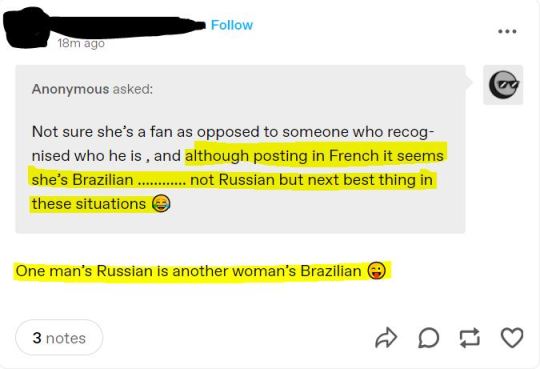
AHAHAHAHA, out of all nations on this planet, they just had to come up with a Brazilian suspect!
And the host (that petty racist I refuse to name) immediately and somewhat gleefully gets on the choo-choo train.
The woman who posted that London pic is not Brazilian. She is desperately (and even provincially) French, but then it does not seem to suit your agenda (for what reason? I wonder 🙄) and then you just couldn't help yourself, could you?
Let's unpack. Yesterday, the X user Véesse, aka Drfolledamour, posted this innocent pic:
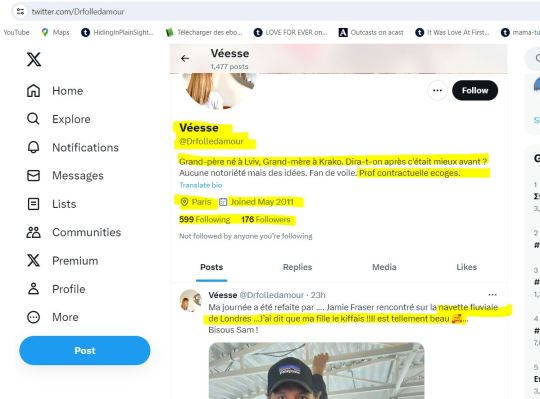
In the process, she gives us plenty of info on her real identity, because she is a normal human being with an average number of social media followers and being middle-aged, she does not give a crap about silly, sick hiding games on the Internet.
First, her initials, V.S (Véesse), with a rather cool & clever pun on the French word déesse/goddess. I like her and would definitely have coffee with her: my type of happy go lucky character.
Then, a very important clue, the X handle - @Drfolledamour. Anon and the vast majority of the non French or Francophile users would be excused not to know that is the French translation of one of my favorite Stanley Kubrick movies, Dr. Strangelove:
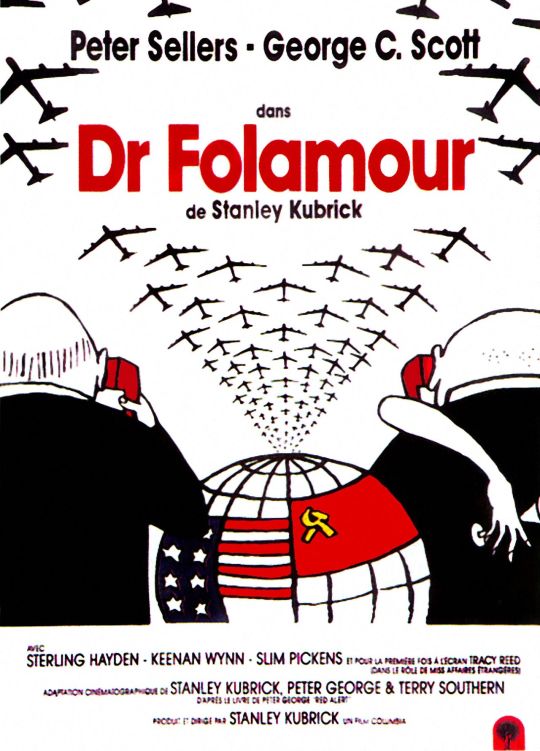
Then, the short bio, in her X profile. We are informed her grandfather was born in Lviv and her grandmother in Krakow. Lviv is in this country:
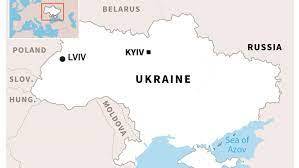
This country, if you don't mind reading, is called the Ukraine.
Krakow is to be placed here:

The country is called Poland. It is bordering Ukraine.
Until Brusilov's army got there, in 1914, Lviv was a part of the Austro-Hungarian empire and Krakow was under Russian control until 1794. Both cities featured sizeable Jewish communities, out of which a hefty chunk emigrated to the more tolerant France, especially in the Interwar period.
V.S. is a French woman proud of her Jewish roots, that's all. She also teaches economics in a French high school near Paris, in Chaville. But that's too complicated for you, I suppose.
However, her spelling sucks: 'j'ai dit que ma fille le kiffais' should be correctly written ' j'ai dit que ma fille le kiffait'. I told him my daughter liked him (a lot).
You see, 'kiffer' means 'to like/enjoy something a lot'. It comes from the Arabic Algerian colloquialism kif (كَيفْ), which means pleasure or amusement, and it went on into the French colonial slang, back in the day Algeria was a French colony. And onwards to the mild, mainstream jargon of today, keeping its meaning intact.
I am sorry, Brazilian friends. No woman of your country and few foreigners would spontaneously kif something or someone, nor make the sort of puns only a French native speaker would. Ask *urv, she just said she speaks French (proficient in buying a metro ticket using Duolinguo, I suppose).
Yes, these people are that stupid. And racist.
This is pathetic and the blogger should excuse herself, at a minimum. Which she won't. Of course.
50 notes
·
View notes
Photo

Happy birthday, Josip Broz Tito! (May 7, 1892)
Leader of Yugoslavia from 1944 to his death in 1980, Josip Broz Tito was born to a multi-ethnic family in what is now Croatia and was then part of the Austro-Hungarian Empire, and identified himself as a Croat. He began reading socialist literature in his teenage years and became active in the labor movement. During World War I he was drafted into the Austro-Hungarian military and was captured by Russian forces. Tito escaped his POW camp and partook in the Bolshevik Revolution before returning to Yugoslavia in 1920 and joining the Communist Party there. He engaged in revolutionary activity in the interwar years and faced prison on multiple occasions. He came to lead the Party in 1939, as World War II was beginning, and led the Yugoslav Partisans in resistance to the Axis occupation. Working alongside the Soviet Red Army, the Partisans liberated Belgrade by 1944, and Tito became the leader of the new socialist Yugoslav government. Tito became known as an independent-minded socialist leader who soon moved his country away from the Soviet bloc in favor of a non-aligned foreign policy. Tito articulated his own contributions to Marxist theory, which have collectively became known as Titoism. The major elements of Titoism include non-alignment in foreign affairs, a plurinational Yugoslav identity, and workers’ self-management in a socialist framework. Subsequent Yugoslav leaders failed to govern as effectively as Tito, and the Socialist Federal Republic of Yugoslavia ultimately dissolved in 1992.
108 notes
·
View notes
Text

Saint Maurice (also Moritz, Morris, or Mauritius; Coptic: Ⲁⲃⲃⲁ Ⲙⲱⲣⲓⲥ) was an Egyptian military leader who headed the legendary Theban Legion of Rome in the 3rd century, and is one of the favorite and most widely venerated saints of that martyred group. He is the patron saint of several professions, locales, and kingdoms.
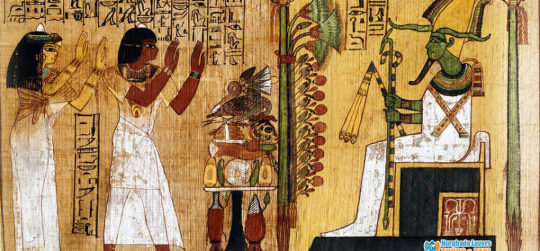
According to the hagiographical material, Maurice was an Egyptian, born in AD 250 in Thebes, an ancient city in Upper Egypt that was the capital of the New Kingdom of Egypt (1575-1069 BC). He was brought up in the region of Thebes (Luxor).
Maurice became a soldier in the Roman army. He rose through the ranks until he became the commander of the Theban legion, thus leading approximately a thousand men. He was an acknowledged Christian at a time when early Christianity was considered to be a threat to the Roman Empire. Yet, he moved easily within the pagan society of his day.
The legion, entirely composed of Christians, had been called from Thebes in Egypt to Gaul to assist Emperor Maximian in defeating a revolt by the bagaudae. The Theban Legion was dispatched with orders to clear the Great St Bernard Pass across the Alps. Before going into battle, they were instructed to offer sacrifices to the pagan gods and pay homage to the emperor. Maurice pledged his men's military allegiance to Rome. He stated that service to God superseded all else. He said that to engage in wanton slaughter was inconceivable to Christian soldiers. He and his men refused to worship Roman deities

Martyrdom
However, when Maximian ordered them to harass some local Christians, they refused. Ordering the unit to be punished, Maximian had every tenth soldier killed, a military punishment known as decimation. More orders followed, the men refused compliance as encouraged by Maurice, and a second decimation was ordered. In response to the Theban Christians' refusal to attack fellow Christians, Maximian ordered all the remaining members of his legion to be executed. The place in Switzerland where this occurred, known as Agaunum, is now Saint-Maurice, Switzerland, site of the Abbey of St. Maurice.
So reads the earliest account of their martyrdom, contained in the public letter which Bishop Eucherius of Lyon (c. 434–450), addressed to his fellow bishop, Salvius. Alternative versions have the legion refusing Maximian's orders only after discovering innocent Christians had inhabited a town they had just destroyed, or that the emperor had them executed when they refused to sacrifice to the Roman gods.
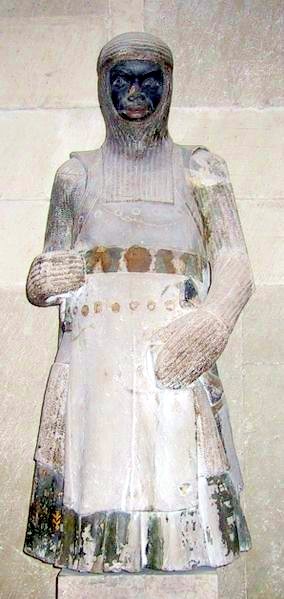
Veneration
Saint Maurice became a patron saint of the German Holy Roman Emperors. In 926, Henry the Fowler (919–936), even ceded the present Swiss canton of Aargau to the abbey, in return for Maurice's lance, sword and spurs. The sword and spurs of Saint Maurice were part of the regalia used at coronations of the Austro-Hungarian emperors until 1916, and among the most important insignia of the imperial throne (although the actual sword dates from the 12th Century). In addition, some of the emperors were anointed before the Altar of Saint Maurice at St. Peter's Basilica. In 929, Henry the Fowler held a royal court gathering (Reichsversammlung) at Magdeburg. At the same time the Mauritius Kloster in honor of Maurice was founded. In 961, Otto I, Holy Roman Emperor, was building and enriching Magdeburg Cathedral, which he intended for his own tomb. To that end,
in the year 961 of the Incarnation and in the 25th year of his reign, in the presence of all of the nobility, on the vigil of Christmas, the body of St. Maurice was conveyed to him at Regensburg along with the bodies of some of the saint's companions and portions of other saints. Having been sent to Magdeburg, these relics were received with great honour by a gathering of the entire populace of the city and of their fellow countrymen. They are still venerated there, to the salvation of the homeland.
Maurice is traditionally depicted in full armor, in Italy emblazoned with a red cross. In folk culture he has become connected with the legend of the Holy Lance, which he is supposed to have carried into battle; his name is engraved on the Holy Lance of Vienna, one of several relics claimed as the spear that pierced Jesus' side on the cross. Saint Maurice gives his name to the town St. Moritz as well as to numerous places called Saint-Maurice in French speaking countries. The Indian Ocean island state of Mauritius was named after Maurice, Prince of Orange, and not directly after Maurice himself.
Over 650 religious foundations dedicated to Saint Maurice can be found in France and other European countries. In Switzerland alone, seven churches or altars in Aargau, six in the Canton of Lucerne, four in the Canton of Solothurn, and one in Appenzell Innerrhoden can be found (in fact, his feast day is a cantonal holiday in Appenzell Innerrhoden).Particularly notable among these are the Church and Abbey of Saint-Maurice-en-Valais, the Church of Saint Moritz in the Engadin, and the Monastery Chapel of Einsiedeln Abbey, where his name continues to be greatly revered. Several orders of chivalry were established in his honor as well, including the Order of the Golden Fleece, Order of Saints Maurice and Lazarus, and the Order of Saint Maurice. Additionally, fifty-two towns and villages in France have been named in his honor.
Maurice was also the patron saint of a Catholic parish and church in the 9th Ward of New Orleans and including part of the town of Arabi in St. Bernard Parish. The church was constructed in 1856, but was devastated by the winds and flood waters of Hurricane Katrina on 29 August 2005; the copper-plated steeple was blown off the building. The church was subsequently deconsecrated in 2008, and the local diocese put it up for sale in 2011. By 2014, a local attorney had purchased the property for a local arts organization, after which the building served as both an arts venue and the worship space for a Baptist church that had been displaced following the hurricane.
On 19 July 1941, Pope Pius XII declared Saint Maurice to be patron Saint of the Italian Army's Alpini (mountain infantry corps). The Alpini have celebrated Maurice's feast every year since then.
The Synaxarium of the Coptic Orthodox Church of Alexandria does not mention Saint Maurice, although there are several Coptic churches named for him.
#african#deep reddish brown skin#north african#coptic#coptic orthodox#alexandria#catholic#roma#roman#gaul#saint maurice#moors#morr#moor#pope#pope pius xii#new orleans#south#south side#baptist#churc#church#egyptian#egypt#kemet#ta meri
196 notes
·
View notes
Text

Sigmund Freud and his two sons Ernest and Martin who served in the Austro-Hungarian Army, 1914
29 notes
·
View notes
Text
THIS DAY IN GAY HISTORY
based on: The White Crane Institute's 'Gay Wisdom', Gay Birthdays, Gay For Today, Famous GLBT, glbt-Gay Encylopedia, Today in Gay History, Wikipedia, and more … March 14



Pi Day is a holiday held to celebrate the mathematical constant π (pi). Pi Day is observed on March 14th (3/14), due to π being roughly equal to 3.14. The Pi Minute is also sometimes celebrated on March 14 at 1:59 p.m. If π is truncated to seven decimal places, it becomes 3.1415926, making March 14 at 1:59:26 p.m. Pi Second (or sometimes March 14, 1592 at 6:53:58 a.m.).
The first Pi Day celebration was held at the San Francisco Exploratorium in 1988, with staff and public marching around one of its circular spaces, and then consuming fruit pies; the museum has since added pizza pies to its Pi Day menu. The founder of Pi Day was Larry Shaw, a now retired physicist at the Exploratorium who still helps out with the celebrations. The Massachusetts Institute of Technology often mails out its acceptance letters to be delivered to prospective students on Pi Day.
Some also celebrate Pi Approximation Day in addition to Pi Day, which can fall on any of several dates:
April 26: The Earth has traveled two radians of its orbit by this day (April 25th in leap years); thus the entire orbit divided by the distance traveled equals pi
July 22: 22/7 in the more common day/month date format, an ancient approximation of pi
November 10: The 314th day of the year (November 9 in leap years)
December 21 1:13 p.m.: The 355th day of the year (December 20 in leap years), celebrated at 1:13 for the Chinese approximation 355/113
On Pi Day, 2004, Daniel Tammet calculated and recited 22,514 decimal digits of pi.
Finally, Albert Einstein was born on Pi Day, 1879.


1864 – Alfred Redl (d.1913) was an Austrian officer who rose to head the counter-intelligence efforts of Austria-Hungary. He was one of the leading figures of pre-World War I espionage. His term in office was marked by innovation, and he used very advanced technology for the time to ensnare foreign intelligence agents. But he was also a spy for the Russians.
Alfred Redl was born in Lemberg, Galicia. His father was a railway clerk, and Alfred was the ninth child in a poor family that would grow even larger. On March 14, 1881, his seventeenth birthday, Redl joined the Austro-Hungarian Army. He was a good student and eventually won a place in the Imperial War College. Whereas others chafed under the discipline of the all-male army, Redl thrived in the homosocial environment. He made the army his true home.
On October 1, 1900, he joined the Counterintelligence Corps. He became responsible for recruiting, training, and dispatching agents for spy missions. In 1907, Redl was appointed Chief of Intelligence for the Army. During a tenure that lasted until 1912, he was known as an innovator: he was among the first to record conversations (on early wax cylinders), to use secret cameras, to adopt a systematic policy to intercept mail, to dust for fingerprints, and to "shadow" suspects. Redl also spearheaded a collaborative exchange of intelligence with Germany and trained an entire generation of Austro-Hungarian spymasters.
Redl's career had two extreme handicaps: money problems and the need to hide his sexuality. The army did not pay its officers well, but nevertheless expected them to live at a level befitting their status. Redl, as it happened, had expensive tastes in everything. His everyday financial life was killing debt.
The stress of Redl's situation was heightened because he was homosexual and had to hide that career-ending fact at all costs. One method he used to deflect suspicion of his sexual orientation during his time in Kazan was to pay court to a (supposedly) married woman. Her reluctance to commit while "married" and Redl's need for a "safe" woman made for a perfect match.
When the Russians discovered Redl was a homosexual, he became doubly vulnerable. The Russians moved in to offer a deal for money and silence. The homosexual, debt-ridden Redl was blackmailed (and bribed) into spying for Russia and betraying his country, his Army, and his Emperor.
Redl was already a veteran of a long and active sexual life when he met and fell in love with Stephan Hromodka. A handsome young cavalry officer, Hromodka had tastes and requirements as extravagant as Redl's and proved to be an expensive obsession. Although Redl and Hromodka both explained that their extravagant lifestyles were made possible by family money, Redl had to sell more and more information to the Russians to finance the arrangements.
When the couple attended public and official functions, Redl introduced Hromodka as his nephew. No one ever challenged him. If anyone had become suspicious about Redl's marital status and the constant presence of a handsome young cavalry officer who might or might not be his nephew, he could cite army regulations: officers had to obtain permission to marry, and there was a long waiting list because, at any one time, half the officers of the General Staff had to be single.
When Redl was transferred to Prague, Major Maximilian Ronge, one of his protégés, became head of counterintelligence in Vienna. Redl had trained Ronge in every technique he had developed and adopted.
Early in April 1913, Ronge received word from his counterpart in the German General Staff about a suspicious letter. Addressed to Herr Nikon Nizetas, c/o General Delivery, Vienna, the letter, unclaimed in Vienna, had been returned to Berlin and opened by the German secret police. The envelope contained the substantial sum of 6,000 crowns and the addresses of espionage centers in Paris and Geneva. The Germans suspected that they had picked up the trail of an important spy.
Ronge then ordered a stakeout at the General Delivery office in Vienna. In early May, two more letters for Herr Nikon Nizetas arrived in Vienna. Ronge's men patiently waited for the mysterious Herr Nizetas to arrive to pick up his mail.
In May Redl travelled to Vienna. He sttopped by the Post Office to pick up the mail he knew would be waiting for Herr Nikon Nizetas.
Ronge's men were able to track "Herr Nizetas" to the Hotel Klomser. Only then did they realize that Herr Nizetas was, in reality, their own Colonel Redl. In one of the classic reversals in the annals of international intrigue, Redl had been caught not only by the very men he trained but also by his own methods.
On the evening of May 24, 1913, the General Staff sent four officers to Redl's room in the Hotel Klomser. Their mission was to find out how much damage Redl had done and who assisted him. They were also instructed to ensure that he would cease to be a problem. Under questioning, Redl reportedly admitted he had spied for Russia since autumn 1912. He claimed that he had been driven to it by the costs of his lifestyle, including keeping Stefan Hromodka.
With the implicit understanding that Redl himself would take the necessary steps, the officers left a loaded Browning pistol on Redl's table and exited his hotel room. Outside on the street just after midnight, they waited until they heard the expected gunshot.
In his suicide note of May 25, 1913, Redl wrote: "Passion and levity have destroyed me. I pay with my life for my sins. Pray for me."


1941 – Today's the birthday of German director, screenwriter and producer, Wolfgang Petersen. Born in Emden, he studied theatre in Berlin and Hamburg and attended the Film and Television Academy in Berlin. His films include Das Boot (1981), The Neverending Story (1984), Enemy Mine (1985), Outbreak (1995), Air Force One (1997), The Perfect Storm, Troy, and Poseidon.
He's remained incredibly mum about his sexuality even though one of his first efforts was the 1977 Die Konsequenz, a b/w 16 mm adaptation of Alexander Ziegler's autobiographical novel of homosexual love, a movie considered "one of the best `70s gay dramas". In its time, the film was considered so radical that when first broadcast in Germany, the Bavarian network turned off the transmitters rather than broadcast it. As the 1980s began, he made the jump to action films, which occasionally featured straight heroes and a few who would ponder and dare fate itself.
His next feature was the World War II epic Das Boot, released in early 1982. The film chronicles the experiences of a German submarine crew engaged in the "Battle of the Atlantic". Though not a financial success, the film received positive reviews and was nominated for six Academy Awards, two of which (for Best Director and Best Adapted Screenplay) went to Petersen himself.
After The NeverEnding Story (1984), Petersen's first full-blown Hollywood effort (although filmed at the Bavaria Film Studios complex in Germany), he finally hit his stride in 1993 with the assassination thriller In the Line of Fire. The 1997 Petersen blockbuster, Air Force One, did very well at the box office, while getting a mix of opinions from movie critics.
If he is gay he deserves a some scorn for completely obscuring the relationship between Achilles and Patroclus in his swords and sandals epic Troy.

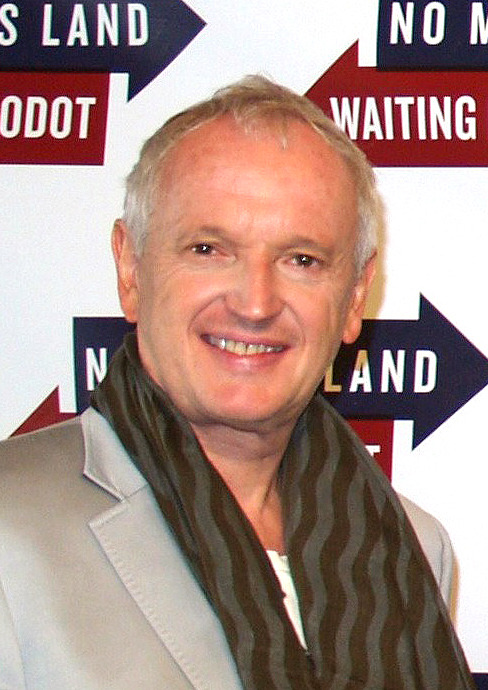
1956 – Sean Mathias is a British theatre director, film director, writer and actor. He was born in Swansea, south Wales. He is best known for directing the film, Bent, and for directing highly acclaimed theatre productions in London, New York, Cape Town, Los Angeles and Sydney. He has also had a notable professional and personal partnership with the actor, Sir Ian McKellen.
Mathias began his career as an actor, making his first appearance on screen in an episode of the cult BBC TV series, Survivors, in 1977 in a small role. In the same year, he played an Irish Guards lieutenant in the film, A Bridge Too Far.
In 1978, Mathias appeared in a production at the Edinburgh Festival Fringe, during which time he met the actor, Ian McKellen, who subsequently became his partner of about nine years.
His acting career continued into the 1980s but his greatest achievements have come in directing and writing. Mathias's play, Cowardice, was produced at the Ambassadors Theatre in London in 1983, starring McKellen. Despite poor reviews, he was undeterred and followed it with Infidelities, A Prayer For Wings, Poor Nanny (1989), and Swansea Boys (1990). His writing also includes a novel, Manhattan Mourning, published in 1988, and the BBC TV film, The Lost Language of Cranes (1992).
In 1999, he directed a revival of Bent, the award-winning play by Martin Sherman that had opened on Broadway in 1979 starring McKellen. Performed as a benefit, this performance featured McKellen, Richard E Grant, Ian Charleson and Ralph Fiennes. After receiving critical acclaim, Mathias directed a full run in 1990 with McKellen alongside Paul Rhys and Christopher Eccleston.
Buoyed by this success, Mathias went on to direct hit shows in both London and on Broadway. Mathias directed his first Stephen Sondheim musical, A Little Night Music, at the National Theatre in 1995, with Judi Dench and Sian Phillips. He worked with Phillips again in 1997, directing her as Marlene Dietrich in Marlene.
Mathias has been based in South Africa since 1997 after visiting the country with the National Theatre in 1994 for a series of workshops. He has continued to direct occasional plays in London, the US and elsewhere.
Despite his focus on theatre direction, Mathias is also known as a film director because of his first - and currently only - feature film, Bent (1997), based on the play that propelled him to success.In 2009 Mathias directed two very different, high-profile West End smash hits: a dream cast revival of Waiting for Godot starring Sir Ian McKellen and Sir Patrick Stewart, and Breakfast at Tiffany's starring Anna Friel.


1965 – Kevin Williamson is an American screenwriter, producer, director and former actor, best known for the horror films Scream, I Know What You Did Last Summer and The Faculty, as well as the popular television series Dawson's Creek and The Vampire Diaries. Williamson's new television show, The Following premiered as a 2012-13 mid-season show on Fox.
He told Entertainment Weekly interviewer Melissa Maerz, "When I was growing up, my mom and dad took me to the Poe museum in Richmond, Virginia. It was a little house downtown, and 'The Raven' was written on the walls. You had to move from room to room to read the whole story. I thought it was the coolest thing in the world."
Inspired by the March 9, 1994, episode of the newsmagazine Turning Point on Danny Rolling, a serial killer in Gainesville, Florida, who preyed on college students, Williamson wrote a horror movie script, originally titled Scary Movie. Its characters had seen many classic horror movies (e.g. A Nightmare on Elm Street, Halloween) and knew all the clichés. Miramax bought the script for $400,000 for their new Dimension Films label in the spring of 1995. Directed by Wes Craven, the film was renamed Scream, and released in The United States on December 20, 1996. It became a commercial blockbuster and critical success—ultimately drawing $173 million in ticket sales worldwide.
Paul Stupin, an executive at Columbia Tri-Star Television, read Scream after the bidding war for the script and was convinced Williamson was just the man to create a television series for his company. The result was Dawson's Creek, a semi-autobiographical tale set in a small coastal community not unlike Oriental. Williamson was the model for the title character, Dawson Leery, a hopeless romantic who is obsessed with movies—especially those of Steven Spielberg. Joey Potter, the platonic girl-next-door, was based on a real life friend of Williamson's when he was young.
Williamson has said that he knew he was gay "as far back as [he] can remember." He came out to his friends and family in 1992.


(Click for Full Monty)
1975 – Johan Paulik, born in Slovakia, Czechoslovakia as Daniel Ferencik, is a Czech pornographic film star who makes films exclusively for Bel Ami Productions. Like all stars for Bel Ami, which specializes in gay pornography, he was in his mid-twenties but he looked to be anywhere from 17-19 years old, with little to no body hair, a muscular body, a very boyish face, and a larger-than-average penis (18 cm).
Paulik's career began as a professional dancer. In 1993, he was discovered by American Bel Ami photographer George Duroy in Bratislava and photos were taken of him, which were soon followed by homosexual porn films. He got his first role in 1994 in the hardcore porno Sauna Paradiso, the second in Lukas' Story followed shortly thereafter. In 1997 the erotic illustrated book Photos of Johan was published in Germany.
In the first few years Paulik's hardcore films were not allowed to be sold or rented in Europe, but they have also been available here since 2001.
As part of the appeal of Bel Ami films, Paulik maintains his heterosexuality, proclaiming that he enjoys sex with men not because he is a homosexual, but because in Prague there is a more open-minded attitude about sexuality. It is the alleged appeal of watching "heterosexual" boys have sex with one another that has made his films (including Sauna Paradiso, his biggest seller to date) such huge successes.
He frequently co-starred with Lukas Ridgeston, with whom he is friends off camera.
He now works behind the scenes at Bel Ami as a director, editor and cameraman (through 2010). Although retired as a performer, Johan often cameos in the behind-the-scenes documentaries he films and edits. Often these are compiled for DVD release, such as in the "Johan's Journals" series.

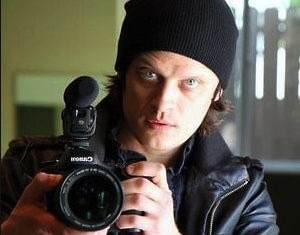
1979 – Steven Greenstreet is an American documentary filmmaker, known for the controversial film, 8: The Mormon Proposition, which was selected to premiere at the 2010 Sundance Film Festival. Currently residing in New York City, he has also worked as a video investigative journalist for The Huffington Post Investigative Fund and a video producer for the US State Department.
The premiere of 8: The Mormon Proposition (2010) at Sundance was met with a lengthy standing ovation despite the intense controversy surrounding it. The film was inspired by ballot measures like California’s "Prop 8," designed to legally prohibit same-sex marriage. Addressing the estimated $22 million Mormons had raised along with internal church documents, the film unravels an extensive campaign carried out by The Church of Jesus Christ of Latter-day Saints (LDS Church) with intent to influence California’s voters.
Contrasting hard statistics with emotionally charged testimonials from gays and families, 8: The Mormon Proposition reveals the detrimental effect of the LDS church’s persistent stance on homosexuality.
The church has declined all of the filmmakers’ requests for interviews; LDS spokesman Michael Purdy has commented on the matter, “We have not seen ‘8: The Mormon Proposition.’ However, judging from the trailer and background material online, it appears that accuracy and truth are rare commodities in this film. Clearly, anyone looking for balance and thoughtful discussion of a serious topic will need to look elsewhere.”

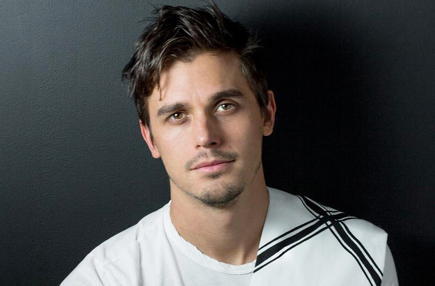
1984 – Antoni Porowski is a Polish-Canadian television personality, actor, chef and model. He is known for his role as the food and wine expert on the Emmy award-winning Netflix series Queer Eye.
Porowski was born in Montreal, Quebec to Polish parents after they emigrated to Canada with his two older sisters. His father is a physician. He grew up speaking Polish, English, and French. He and his parents moved to Glade Springs, West Virginia when he was twelve, and he lived between there and Montreal throughout his high school years before finally returning to Montreal to attend Marianopolis College and then university. His mother and Porowski do not have a good relationship as brought out in season four of Queer Eye.Post-graduation from Concordia University with a bachelor's degree in Creative Arts, Porowski moved to New York City to study acting at the Neighborhood Playhouse School of the Theatre, from which he graduated in 2011. He taught himself to cook by referring to his grandmother's cooking techniques. He is also a close friend of the original Queer Eye’s first season cooking and sommelier Ted Allen who was a mentor.
Upon moving to New York City, Porowski began auditioning for various acting roles. He has stated that being Polish made it difficult for him to find work, which at the time made him consider anglicizing his last name. He has landed roles in movies such as Elliot Loves (2012), Daddy's Boy (2016), The Pretenders (2018), and as the lead officer in a 2014 episode of TV series The Blacklist. Porowski was also featured in the 2015 short docudrama about the Vinnytsia massacre, To My Father, as Adam Bandrowski. The short film was part of the 2016 Cannes Film Festival's Short Film Corner.
In the meantime, he worked in food service to cover his rent, first working as a busboy at a family-run Polish restaurant. He worked his way up in the restaurant industry, working as a waiter and sommelier, eventually managing a Bond Street sushi restaurant. Porowski lives in the same neighborhood as Ted Allen, the original Queer Eye food and wine expert, and current host of Food Network cooking competition Chopped. The two became friends, and for a time Porowski worked for Allen as a personal chef.
In December 2017, it was announced that Porowski would play the role of food and wine expert in the Netflix revival of Queer Eye, which aired in February 2018. The second season of the show was released in June 2018.In April 2018, Porowski signed a deal with Houghton Mifflin Harcourt for his first cookbook, released in Spring 2019. In June 2018, he announced that he would be opening The Village Den, a fast-casual restaurant in New York City's West Village. Additionally, Porowski deals vintage furniture.
Porowski states that his sexuality is "a little more fluid along the spectrum" and that he prefers not to label. He dated Joey Krietemeyer for more than seven years, but the relationship ended in October 2018. He confirmed via Instagram that December that he was dating Trace Lehnhoff. However, the two split after one year of dating. In October 2019, he confirmed via Instagram that he is dating Kevin Harrington.
Porowski and his Queer Eye costar Jonathan Van Ness trolled the internet by setting up a joint Instagram account, pretending to be a couple. Later they confirmed that there was nothing serious to it.
In the Queer Eye episode titled, "Lost Boy", Porowski revealed that he has struggled with addiction issues in the past.


1990 – The Idaho Court of Appeals finds a privacy issue in sex in enclosed restroom stalls.


10 notes
·
View notes